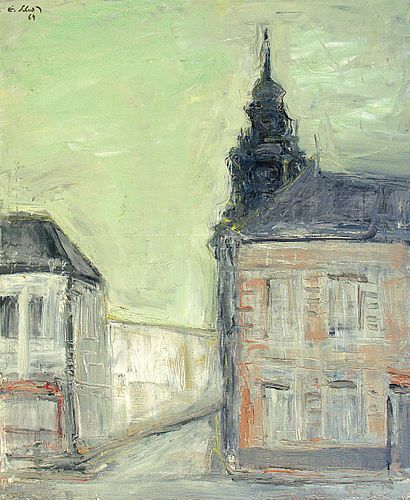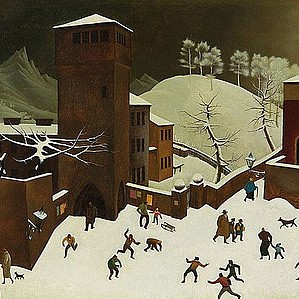ERICH SCHMID (Vienna 1908 - 1984 Paris) Townhall, 1961
Lot 142
Estimate:
EUR€1,500 - EUR€4,000
$1,630.43 - $4,347.83
Absentee vs Live bid
Two ways to bid:
- Leave a max absentee bid and the platform will bid on your behalf up to your maximum bid during the live auction.
- Bid live during the auction and your bids will be submitted real-time to the auctioneer.
Bid Increments
| Price | Bid Increment |
|---|---|
| EUR€0 | EUR€10 |
| EUR€100 | EUR€50 |
| EUR€700 | EUR€100 |
| EUR€1,000 | EUR€200 |
| EUR€3,000 | EUR€300 |
| EUR€3,600 | EUR€400 |
| EUR€4,000 | EUR€500 |
| EUR€7,000 | EUR€1,000 |
| EUR€16,000 | EUR€2,000 |
| EUR€30,000 | EUR€3,000 |
| EUR€36,000 | EUR€4,000 |
| EUR€40,000 | EUR€5,000 |
About Auction
By Widder Auctions
May 19, 2022
Set Reminder
2022-05-19 11:00:00
2022-05-19 11:00:00
America/New_York
Bidsquare
Bidsquare : Masterpieces
https://www.bidsquare.com/auctions/widder-auctions/masterpieces-9287
Masterpieces of classical modernism by Austrian and international artists coming up for auction in Vienna on May 19th Widder Auctions office@widderauktionen.com
Masterpieces of classical modernism by Austrian and international artists coming up for auction in Vienna on May 19th Widder Auctions office@widderauktionen.com
- Lot Description
ERICH SCHMID*
(Vienna 1908 - 1984 Paris)
Townhall, 1961
oil/canvas 73 x 60 cm
signed E. Schmid and dated 61
depicted in Erich Schmid, Vienna 2002, p. 65
Provenance: Fine Arts Widder Vienna
ESTIMATE °€ 1.500 - 4.000
Austrian painter and graphic artist of the 20th century. Representative of exile art. Came from a Jewish family. Studied psychology and psychoanalysis with Wilhelm Reich. Studied at the Kunstgewerbeschule in Vienna and the Reimann Kunstschule in Berlin. In the 1930s, close contact with Oskar Kokoschka, Alfred Kubin and Hans Böhler, exhibited at the Vienna Secession. Lifelong friendship with the writer Jean Améry. Fled to Belgium in 1938 and Paris in 1940, imprisoned with Améry in French internment camp. His parents and brother were murdered in Auschwitz. Flea from the camp and joined the Resistance, in 1945 the Foreign Legion in Italy. From 1946 back in Paris, friends with the painter Eva Friedmann. From 1954 promotion by the Mendel family. In 1958 he met his future partner Gail Singer, who was a member of the artist group CoBrA. Exhibited with the painters of the Lyon Circle. Developed his own style with influences of interwar expressionism, cubism and futurism. Counts to the abstract expressionism, color dabs and strokes comparable to the action paintings of Jackson Pollock. Created mainly still lifes and cityscapes close to the border of the non-representational.
Erich Schmid's pictures are direct testimonies and the legacy of a particularly consistent and at the same time tragic artist's existence. After fleeing the Nazis, Erich Schmid manages to gain a foothold in Paris, but the living conditions are extremely adverse. In his works, the artist captures the mood of those years. They do not serve as an escape from reality or a moral exaggeration of the post-war period of deprivation, but are the unadulterated testimonies of his life and at the same time expressions of his own psyche. He first studied psychology in Vienna before going to the Vienna School of Applied Arts from 1930 to 1934. In his pictures he always seeks the harmony of inner and outer reality. By combining a post-impressionist pictorial language with expressionist pictorial statements, he went against the taste of the times. The abstract painting that dominated the post-war art scene in Paris did not suit him. Erich Schmid remains true to his own style and his own artistic goals even under difficult conditions. Solitary and intellectual, both as a person and as an artist, he would rather refrain from critical acclaim than conform. Jean Amery, Erich Schmid's childhood friend, with whom he shares the fate of being persecuted by the Nazis, the experience of flight and internment in France, writes about his pictures: "I can't imagine my life without these pictures any more than (...) without the feelings that I experience." (...) "I would indeed be unhappy if I were forced to live my life without Erich Schmid's paintings. His favorite subject is Paris. Often deserted, Erich Schmid does not just present the city to us as a lively, pulsating place, but also creates a remote, unworldly impression through the diffuse lighting situation, which does not allow for a temporal localization, and the complete absence of its inhabitants. The architecture is composed of a shimmering network of lines. For Erich Schmid, the city is a projection surface and its image is always a symbol with psychological quality.
PLEASE NOTE:
The purchase price consists of the highest bid plus the buyer's premium, sales tax and, if applicable, the fee of artists resale rights. In the case of normal taxation (marked ° in the catalog), a premium of 24% is added to the highest bid. The mandatory sales tax of 13% is added to the sum of the highest bid and the buyer's premium. The buyer's premium amounts to 28% in case of differential taxation. The sales tax is included in the differential taxation. - Shipping Info
-
Shipping
We will send you the invoice shortly after the auction. As soon as we have recieved the amount, the art can be picked up at Johannesgasse 9-13, 1010 Vienna. Please note that the buyer is responsible for pick-up and shipping of the lot.
Should you wish to ship your items, please contact: Mailboxes Email: oper@mbe-co.at Tel: 01 5128855
Please note that storage fees may apply, should the pieces not be picked up within 14 days after invoicing for domestic and 28 days for international transportation.
Our team will be happy to assist you with any further information at office@widderauktionen.com or at 0043 676 555 66 10.
-
- Buyer's Premium



 EUR
EUR CAD
CAD AUD
AUD GBP
GBP MXN
MXN HKD
HKD CNY
CNY MYR
MYR SEK
SEK SGD
SGD CHF
CHF THB
THB












